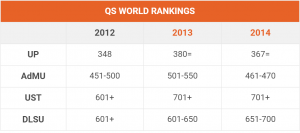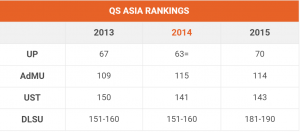Comparison will be inevitable in a post-ASEAN integration era. How are rankings influencing the Philippines’ higher education sector?
First of two parts
MANILA, Philippines – Out of the thousands of higher education institutions (HEIs) in the Philippines, only 4 universities have consistently made it to the Quacquarelli Symonds (QS) Asian and world university rankings in recent years.
State-run University of the Philippines (UP) leads the pack dominated by private schools: Ateneo de Manila University, University of Santo Tomas, and De La Salle University.

But in Asia’s top 100 universities for 2015, UP is the lone wolf from the Philippines. In comparison, our ASEAN neighbors – Malaysia, Thailand, and Singapore – have more schools in the list topped by the National University of Singapore. (READ: 12 ASEAN schools in top 100 of Asian university rankings)

But one is better than nothing. In another major international rankings Thomson Reuters’ Times Higher Education (THE) Asia University Rankings 2015, none of the 4 Philippine schools made it to the top 100.
Only 4 ASEAN schools made it to the list:
QS gives more weight on academic reputation, while THE Asia University Rankings focuses on research – an area that top Philippine universities are “embarrassed” about.
Comparison will be inevitable in a post-ASEAN integration era, and this makes rankings all the more crucial for Philippine schools. But according to an ASEAN education expert, at this point “the rankings game is a perception game” for the Philippines.
Rankings gap
“Perceptions are real in their consequences. They have consequences for the way your people are treated, because they become vulnerable to condescension,” Cynthia Bautista, one of the commissioners from the Commission on Higher Education (CHEd), told Rappler.
Take the case of UP, the country’s premier state university. It dropped from 63rd to 70th in the 2015 QS Asian rankings, but the university is not the least bit worried – not when it remains the top university in the country.
“Bumaba e, anong magagawa natin? (It went down, so what can we do?)” UP vice president for public affairs Prospero de Vera said when asked about the drop in rankings.
This is the same university that attributed improved rankings in 2014 to its pursuit of internationalization.
Now that it went down 7 notches, de Vera pointed out there are indicators in the rankings where UP is “naturally disadvantaged.” More importantly, UP’s priority, he said, is to serve Filipinos.
While that is true, its own charter also mandates UP to become a regional and global university. But in the ASEAN region alone, the rankings gap is already huge between UP and the top universities in Singapore, Malaysia, and Thailand.
Collaboration or competition?
But years ago, Malaysia and Thailand used to be the Philippines’ “equals” in education, according to Bautista, who also chairs the regional task force on the ASEAN Qualifications Reference Framework.
Today, the difference is glaring. Only one public school from the Philippines made it to the 2015 QS University Rankings for Asia, compared to 11 public institutions from Thailand, and 14 from Malaysia.
Bautista said the Philippines is playing catch-up in education – a bit too late, compared to other ASEAN nations that have started their “cramming” over a decade ago.
“ASEAN integration is pushing us to cram. What are we cramming? We’re cramming the education paradigm shift to learner-centered education… We’re cramming K to 12… We’re cramming all of the changes that have to be done in connection with the paradigm shift,” the commissioner said.
Fortunately, the mood among ASEAN schools is still friendly at this early stage of the integration, de Vera said, as countries try to help each other develop.
But competition is just around the corner.
“Soon enough, once investments move across countries, then you will see the competitiveness,” he added.
This is why for Bautista, the Philippines has to be globally competitive sooner rather than later.
“The ASEAN way is collaboration rather than competition, but the context we’re operating in is also of competitive context. So we also have to be globally competitive. We also have to see ourselves as competing even while we’re collaborative…. You can collaborate more meaningfully and give of yourself if you’re also developed,” Bautista explained.
Balancing act
Although UP admits rankings affects its reputation, the university still looks at the numbers more as a guide than a driving force in its decision-making. (READ: 8 ways PH higher education can prepare for ASEAN 2015)
“It alerts us to benchmark what we’re doing with the universities in the region, especially in the ASEAN. That’s the advantage because you see what the other universities are doing, and it guides the position of UP in discussions,” de Vera said.
Even at the national level, while the country is trying to rank, support for HEIs is not rankings-driven.
“We’re not yet supporting in a large scale, like China and India – not the kind of programs they already have – although we are supporting through Centers of Excellence [and] helping them develop,” Bautista said.
Because rankings are “supposedly indicators of the quality of an institution,” the Philippines can’t afford to ignore the numbers, or negative perceptions of its higher education will persist.
“Kulang ka [sa] 12 years, they think low quailty. ‘Di ka nagrarank, they think low quality. So the dilemma is you know in substance that’s not necessarily the case, that you don’t rank doesn’t mean your quality is poor…. [Dapat] may consciousness tayo ng handling perceptions,” she added.
(If you have less than 12 years, they think low quality. If you don’t rank, they think low quality. So the dilemma is you know in substance that’s not necessarily the case, that you don’t rank doesn’t mean your quality is poor…. We must have a consciousness of handling perceptions.)
But in a landscape where other ASEAN countries already have big dreams for their higher education sector – Malaysia, for example, wants to become an education hub in the region – Bautista said the Philippines has to first focus on implementing reforms that are long overdue.
It’s a balancing act between playing the perception game well and pursuing quality in higher education. After all, as de Vera also noted, schools with better quality of education will be the winners once ASEAN integrates. – Rappler.com